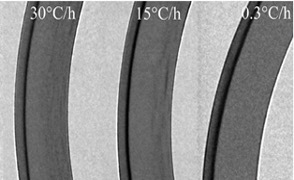Advanced Characterization Methods for Nuclear
Fuel and its Cladding
J. Bertsch1,*,
L.I. Duarte1, W. Gong2, D. Grolimund3, G. Kuri1,
M. Martin4, P. Trtik5, R. Zubler1
1 Laboratory
for Nuclear Materials, Paul Scherrer Insitut (PSI), 5232 Villigen PSI,
Switzerland
2 Northwestern
Polytechnical University, 710072 Xi’an, China
3 Laboratory for Synchrotron Radiation and Femtochemistry,
Paul Scherrer Insitut (PSI), Switzerland
4 Hot Laboratory,
Paul Scherrer Insitut (PSI), Switzerland
5 Laboratory
for Neutron Scattering and Imaging, Paul Scherrer Insitut (PSI), Switzerland
ABSTRACT:
Nuclear fuel elements in light water reactors are subject to high temperatures
and pressure, corrosive water and strong irradiation. These factors lead to properties
changes of the UO2 fuel pellet and the surrounding cladding, made of
a zirconium alloy. Investigations of fuel rods after service are of high
interest for the fuel vendors, utilities, and regulators. Post-irradiation
examinations (PIE) typically aim at the performance of the fuel and its safety.
Of interest is the increase of the fuel burn-up, i.e. the number of fissions
and thus energy production per fissile material. The higher burn-up leads to
changes in the fuel pellet structure, and, due to the corrosion at the hot
surface of the cladding in the reactor water, to an increased take-up of
hydrogen into the metal, forming brittle hydrides, which potentially
deteriorate the cladding mechanical properties. PIE foresees non-destructive
and destructive testing, with various macro- and microscopic, as well as
spectroscopic methods. The Paul Scherrer Institute hosts, besides a hotlab,
several large-scale facilities, including a synchrotron (SLS) and a spallation
neutron source (SINQ). These are used for advanced characterization of nuclear
fuel and cladding, with X-ray diffraction (XRD), absorption (XAS), and neutron
radiography, respectively. The investigations lead to a deeper understanding of
the changes of the pellet-cladding system with burn-up, with respect to the
structural, chemical, physical and mechanical properties.

Figure 1.
fuel micro-XRD, increased spot streaking with burn-up (from left to
right).

Figure
2. neutron radiography of hydrides accumulation
in claddings after different cooling rates.
Keywords:nuclear fuel, cladding, synchrotron, neutron radiography

Johannes Bertsch has a PhD from the University of Karlsruhe in Germany. After several years in industry, he joined the Paul Scherrer Institut (PSI) in Switzerland where he leads a research group working on nuclear fuels. He has published numerous papers in reputed journals and at international conferences.